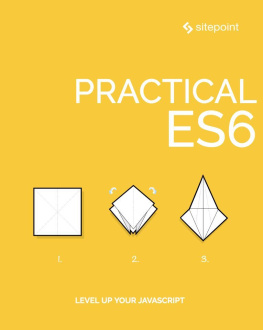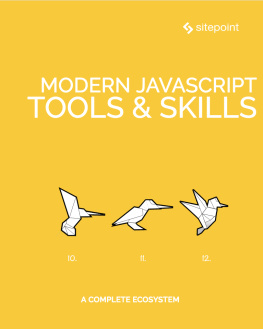Aurelio De Rosa - Practical ES6
Here you can read online Aurelio De Rosa - Practical ES6 full text of the book (entire story) in english for free. Download pdf and epub, get meaning, cover and reviews about this ebook. year: 2018, publisher: SitePoint, genre: Computer. Description of the work, (preface) as well as reviews are available. Best literature library LitArk.com created for fans of good reading and offers a wide selection of genres:
Romance novel
Science fiction
Adventure
Detective
Science
History
Home and family
Prose
Art
Politics
Computer
Non-fiction
Religion
Business
Children
Humor
Choose a favorite category and find really read worthwhile books. Enjoy immersion in the world of imagination, feel the emotions of the characters or learn something new for yourself, make an fascinating discovery.
- Book:Practical ES6
- Author:
- Publisher:SitePoint
- Genre:
- Year:2018
- Rating:3 / 5
- Favourites:Add to favourites
- Your mark:
- 60
- 1
- 2
- 3
- 4
- 5
Practical ES6: summary, description and annotation
We offer to read an annotation, description, summary or preface (depends on what the author of the book "Practical ES6" wrote himself). If you haven't found the necessary information about the book — write in the comments, we will try to find it.
Practical ES6 — read online for free the complete book (whole text) full work
Below is the text of the book, divided by pages. System saving the place of the last page read, allows you to conveniently read the book "Practical ES6" online for free, without having to search again every time where you left off. Put a bookmark, and you can go to the page where you finished reading at any time.
Font size:
Interval:
Bookmark:
Copyright 2018 SitePoint Pty. Ltd.
- Cover Design: Alex Walker
All rights reserved. No part of this book may be reproduced, stored in a retrieval system or transmitted in any form or by any means, without the prior written permission of the publisher, except in the case of brief quotations embodied in critical articles or reviews.
The author and publisher have made every effort to ensure the accuracy of the information herein. However, the information contained in this book is sold without warranty, either express or implied. Neither the authors and SitePoint Pty. Ltd., nor its dealers or distributors will be held liable for any damages to be caused either directly or indirectly by the instructions contained in this book, or by the software or hardware products described herein.
Rather than indicating every occurrence of a trademarked name as such, this book uses the names only in an editorial fashion and to the benefit of the trademark owner with no intention of infringement of the trademark.

Published by SitePoint Pty. Ltd.
48 Cambridge Street Collingwood
VIC Australia 3066
Web: www.sitepoint.com
Email: books@sitepoint.com
SitePoint specializes in publishing fun, practical, and easy-to-understand content for web professionals. Visit http://www.sitepoint.com/ to access our blogs, books, newsletters, articles, and community forums. Youll find a stack of information on JavaScript, PHP, design, and more.
Theres no doubt that the JavaScript ecosystem changes fast. Not only are new tools and frameworks introduced and developed at a rapid rate, the language itself has undergone big changes with the introduction of ES2015 (aka ES6). Understandably, many articles have been written complaining about how difficult it is to learn modern JavaScript development these days. We're aiming to minimize that confusion with this set of books on modern JavaScript.
This book provides an introduction to many of the powerful new JavaScript language features that were introduced in ECMAScript 2015, as well as features introduced in ECMAScript 2016 and 2017. It also takes a look at the features planned for ECMAScript 2018 in this rapidly evolving language.
This book is for all front-end developers who wish to improve their JavaScript skills. Youll need to be familiar with HTML and CSS and have a reasonable level of understanding of JavaScript in order to follow the discussion.
Code in this book is displayed using a fixed-width font, like so:
A Perfect Summer's DayIt was a lovely day for a walk in the park.The birds were singing and the kids were all back at school.
Where existing code is required for context, rather than repeat all of it, will be displayed:
function animate() { new_variable = "Hello";}Some lines of code should be entered on one line, but weve had to wrap them because of page constraints. An indicates a line break that exists for formatting purposes only, and should be ignored:
URL.open("http://www.sitepoint.com/responsive-web-design-real-user-testing/?responsive1");Youll notice that weve used certain layout styles throughout this book to signify different types of information. Look out for the following items.
Tips provide helpful little pointers.
Notes are useful asides that are relatedbut not criticalto the topic at hand. Think of them as extra tidbits of information.
... pay attention to these important points.
Warnings highlight any gotchas that are likely to trip you up along the way.
In this tutorial, I'll introduce let and const, two new keywords added to JavaScript with the arrival of ES6. They enhance JavaScript by providing a way to define block-scope variables and constants.
letUp to ES5, JavaScript had only two types of scope, function scope and global scope. This caused a lot of frustration and unexpected behaviors for developers coming from other languages such as C, C++ or Java. JavaScript lacked block scope, meaning that a variable is only accessible within the block in which its defined. A block is everything inside an opening and closing curly bracket. Let's take a look at the following example:
function foo() { var par = 1; if (par >= 0) { var bar = 2; console.log(par); // prints 1 console.log(bar); // prints 2 } console.log(par); // prints 1 console.log(bar); // prints 2}foo();After running this code, you'll see the following output in the console:
1212What most developers coming from the languages mentioned above would expect, is that outside the if block you can't access the bar variable. For example, running the equivalent code in C results in the error 'bar' undeclared at line ... which refers to the use of bar outside the if.
This situation changed in ES6 with the availability of block scope. The ECMA organization members knew that they could not change the behavior of the keyword var, as that would break backward compatibility. So they decided to introduce a new keyword called let. The latter can be used to define variables limiting their scope to the block in which they are declared. In addition, unlike var, variables declared using let aren't hoisted. If you reference a variable in a block before the let declaration for that variable is encountered, this results in a ReferenceError. But what does this mean in practice? Is it only good for newbies? Not at all!
To explain you why you'll love let, consider the following code taken from my article 5 More JavaScript Interview Exercises:
var nodes = document.getElementsByTagName('button');for (var i = 0; i < nodes.length; i++) { nodes[i].addEventListener('click', function() { console.log('You clicked element #' + i); });}Here you can recognize a well-known issue that comes from variable declaration, their scope, and event handlers. If you don't know what I'm talking about, go check the article I mentioned and than come back.
Thanks to ES6, we can easily solve this issue by declaring the i variable in the for loop using let:
var nodes = document.getElementsByTagName('button');for (let i = 0; i < nodes.length; i++) { nodes[i].addEventListener('click', function() { console.log('You clicked element #' + i); });}The let statement is supported in Node and all modern browsers. There are, however, a couple of gotchas in Internet Explorer 11 which you can read about in the ES6 compatibility table.
A live demo that shows the difference between var and let is available at JSBin.
const
Font size:
Interval:
Bookmark:
Similar books «Practical ES6»
Look at similar books to Practical ES6. We have selected literature similar in name and meaning in the hope of providing readers with more options to find new, interesting, not yet read works.
Discussion, reviews of the book Practical ES6 and just readers' own opinions. Leave your comments, write what you think about the work, its meaning or the main characters. Specify what exactly you liked and what you didn't like, and why you think so.













